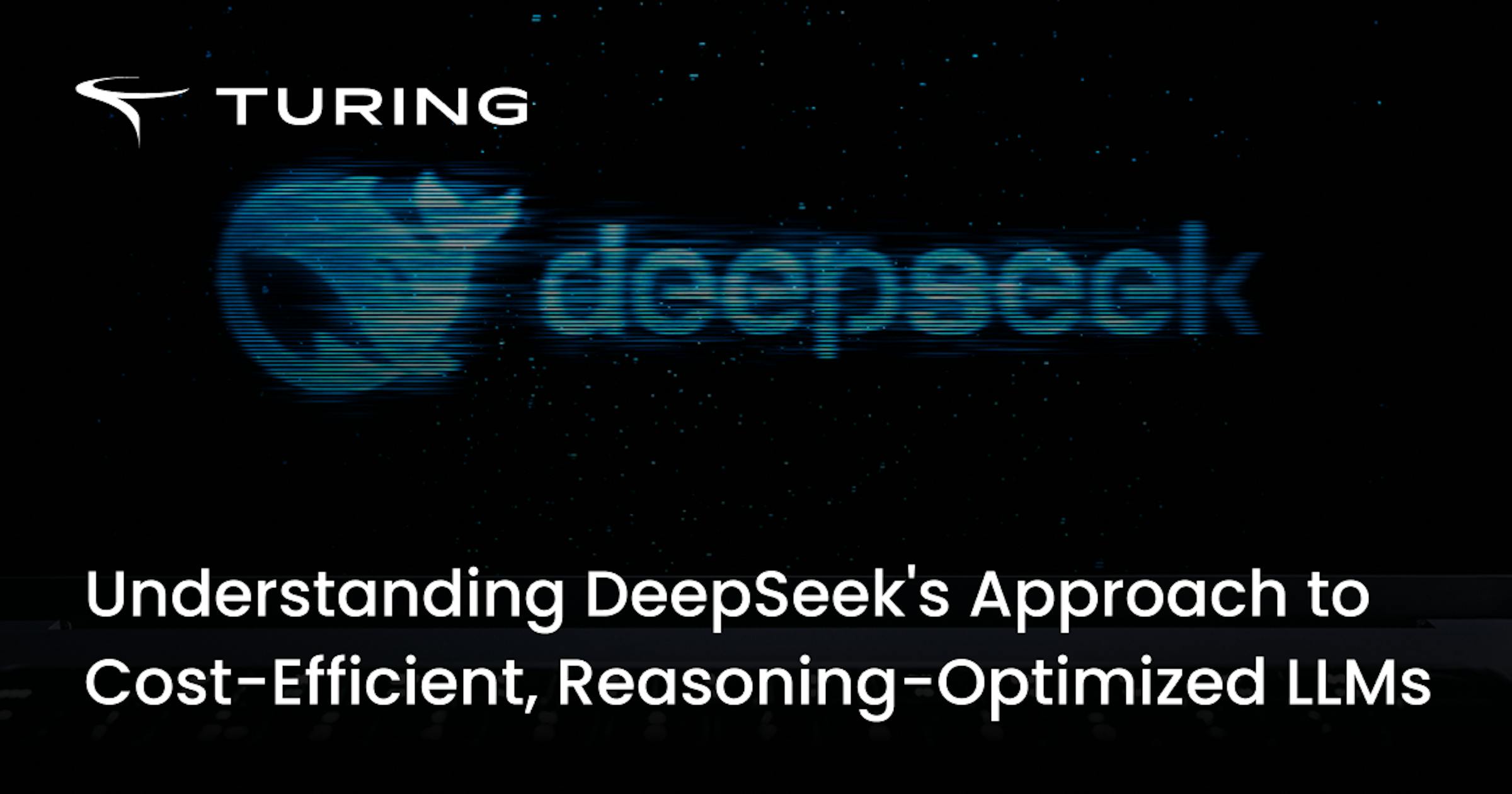What Makes DeepSeek’s LLMs Cost-Efficient and Reasoning-Centric?

Anjali Chaudhary
•6 min read
- LLM training and enhancement

The AI landscape is evolving—enterprises no longer need massive infrastructure or expensive APIs to deploy AI with advanced reasoning. DeepSeek-R1 represents a major leap in high-performance AI models, delivering multi-step reasoning capabilities and improved accuracy at roughly 3-4% of standard OpenAI o1’s API pricing.
For enterprises, this unlocks:
- New high-value AI use cases using structured or multi-step reasoning.
- Advanced problem-solving and deeper data insights.
- A cost-effective and efficient way to deploy LLMs at scale.
- Improved logic and performance for math, coding, and complex decision-making.
Architecture analysis– How does DeepSeek-R1 deliver higher performance at a lower cost?
DeepSeek-R1 is built on DeepSeek-V3, a first-of-its-kind large language model (LLM) designed for logic and efficiency using Mixture-of-Experts (MoE) infrastructure.
While the full model has 671 billion components, only a smaller portion (about 37 billion) are used at a time, which helps reduce costs and speed up performance without sacrificing quality.
Other design choices that enable cost-efficiency include:
1. MoE for scalability
- DeepSeek-R1 uses an MoE approach, which means it only activates the parts of the model needed for each task.
- This allows R1 to reduce compute costs without sacrificing quality.
- MoE is more efficient than traditional models (like GPT-4), enabling it to run faster, reason deeper, scale efficiently, and operate in more limited or on-prem environments.
2. Reinforcement Learning-First Training (RL-First)
- Unlike the traditional Supervised Fine-Tuning (SFT) → RLHF pipeline, DeepSeek-R1-Zero was trained using RL from the start, allowing reasoning capabilities to emerge autonomously.
- Natural reasoning allowed DeepSeek-R1 to identify and fine-tune language inconsistencies and logic gaps.
3. Multi-stage optimization (How DeepSeek-R1 improved on R1-Zero)
- DeepSeek-R1-Zero: Trained entirely using reinforcement learning, which led to strong reasoning skills but often produced confusing or less readable responses.
- DeepSeek-R1: Introduced a "cold-start" supervised fine-tuning (SFT) phase using a curated dataset of structured reasoning examples before applying reinforcement learning. This helped the model generate clearer, more advanced answers–while maintaining lower compute.
The result? DeepSeek-R1 achieves performance comparable to OpenAI’s o1-1217, but at a fraction of the cost.
Where does DeepSeek-R1 excel—and where does it struggle?
Strengths:
- Mathematical & logical problem-solving: Effective at structured, step-by-step reasoning–especially for math, logic, puzzles, complex tasks, and chain-of-thought thinking with high accuracy.
- Code review & debugging: Performs well as a senior code reviewer. It can identify bugs, suggest improvements, and explain errors in a way that mirrors an experienced developer, making it useful for tech audits, code reviews, and debugging workflows.
- Solution validation & correction: Excels in analyzing AI-generated outputs from other models or tools, validating the logic, and ensuring accuracy.
Limitations:
- Limited tool-use & execution: Unlike OpenAI’s o1 or Anthropic’s Claude, DeepSeek-R1 cannot interact with external tools, execute actions, or navigate file systems. It’s optimized for reasoning, not action-based workflows.
- Distilled versions lose depth: Smaller variants (like DeepSeek R1-Distill-Qwen-32B) aim to reduce compute costs but sacrifice depth. They retain ~90% of R1’s core capabilities but may underperform in edge cases or nuanced problem-solving.
- Multi-turn conversation handling: Struggles with extended, dynamic conversations and long-form dialogue management, especially compared to GPT-4 or Claude Sonnet.
- General NLP fluency vs. task-specific reasoning: While DeepSeek is strong in logic-driven tasks, it’s not as naturally conversational or linguistically fluid at GPT-4. It performs best when the task is structured and reasoning-heavy, rather than open-ended, creative, or casual.
What is the role of reinforcement learning in DeepSeek’s training?
1. Pure RL-based training: Learning reasoning from scratch
DeepSeek-R1’s development represents a major shift in how LLMs acquire reasoning skills. Unlike most models that follow the traditional SFT→ RLHF pipeline, DeepSeek-R1-Zero was trained entirely with RL from scratch, allowing reasoning capabilities to emerge naturally.
Why this approach was revolutionary:
- No reliance on pre-labeled human demonstrations: The model discovered its own reasoning strategies instead of mimicking human-annotated responses.
- Developed emergent reasoning behaviors: With no predefined task-specific training, the model learned structured reasoning entirely through reward-based optimization.
- Improved cost-efficiency: Since human-labeled datasets are expensive to create, RL-first training made it possible to train DeepSeek-R1-Zero at a lower cost than traditional models.
However, this approach came with challenges—DeepSeek-R1-Zero struggled with readability, clarity, and consistency in responses. To address these issues, DeepSeek-R1 introduced a refined training pipeline that combined RL with a small but critical amount of high-quality human data.
2. The "Aha Moments" – How DeepSeek-R1-Zero evolved on its own
One of the most fascinating aspects of DeepSeek-R1-Zero’s RL-first training was the emergence of self-improvement through iterative reasoning–without any supervised fine-tuning. As the model learned to optimize for reward, several human-like behaviors began to surface organically:
- Self-verification: The model learned to check its own work, verifying intermediate steps before arriving at a final answer.
- Adaptive error correction: When the model made mistakes, it naturally adjusted its reasoning process in subsequent iterations to improve accuracy.
- Extended Chain-of-Thought (CoT) reasoning: The model began generating longer, more structured explanations that mirrored how humans problem-solve–breaking down steps, validating assumptions, and showing signs of adaptive learning.
These organic improvements showed up in real benchmarks. During training, DeepSeek-R1-Zero’s pass@1 accuracy on the AIME 2024 math benchmark jumped from 15.6% to 71.0%, purely through reward-based self-iteration. This demonstrates how far raw reasoning capabilities can evolve without direct human interference.
3. Cold-start data strategy: How DeepSeek-R1 improved on R1-Zero
While DeepSeek-R1-Zero displayed strong logic and adaptability, its responses were often overly verbose, inconsistently structured, and lacked clarity.
To address this, the team introduced a “cold-start” supervised fine-tuning (SFT) phase before applying reinforcement learning.
How cold-start data improved DeepSeek-R1:
- Introduced structured, human-like responses: A small, carefully curated dataset of high-quality reasoning chains was used to train the model before RL kicked in.
- Fixed language consistency issues: DeepSeek-R1-Zero sometimes mixed languages in its outputs (e.g., switching between English and Chinese). Cold start fine-tuning eliminated this problem by reinforcing consistent language usage.
- Improved readability: The model’s responses became more structured, concise, and user-friendly, addressing issues from R1-Zero’s raw RL-only training.
This hybrid training strategy—small-scale fine-tuning followed by RL-first learning—allowed DeepSeek-R1 to maintain its strong reasoning capabilities while improving coherence and usability.
Does high-quality human data still matter for AI training?
Even though DeepSeek-R1’s RL-first training enabled strong reasoning, it also revealed limitations without human supervision:
- Language clarity: DeepSeek-R1-Zero’s responses were often verbose or inconsistent.
- Handling ambiguity: Tasks with multiple valid interpretations–like nuanced questions or under-specified prompts–suffered without human-labeled data.
How high-quality human data improves LLMs:
- Teaches clear, structured reasoning using curated human examples that show models how to break down problems and community more clearly step-by-step.
- Human-labeled data helps models avoid unnecessary complexity, refine decision-making, and provide more relevant outputs.
- Combines precision with usability. The best-performing models use both RL and high-quality human data to build systems that aren’t just intelligent but also reliable, consistent, and accurate.
The future of enterprise AI: Are hybrid AI models the future?
DeepSeek-R1 stands out as a powerful, cost-efficient AI model optimized for structured reasoning. For enterprises looking to leverage high-performance AI without massive computational costs, DeepSeek offers a compelling alternative to proprietary models like OpenAI’s o1 and Claude Sonnet.
If you’re building an AI-powered coding assistant, research tool, or structured problem-solver, DeepSeek is one of the best open-source options available today. Its highly optimized reasoning engine makes it ideal for tasks that require logical processing, structured analysis, and cost-efficient AI deployment.
However, if you need fully autonomous AI agents capable of executing tasks, navigating repositories, or running real-world workflows, a hybrid approach is the best path forward. Pairing DeepSeek for structured reasoning with an execution-optimized model like Claude Sonnet or OpenAI’s o1 will enable enterprises to leverage both reasoning accuracy and real-world automation.
As enterprises continue adopting AI, the future lies in combining specialized models to create hybrid AI solutions that balance high-level reasoning, tool execution, and workflow automation.
Turing helps enterprises navigate AI model selection, refinement, and integration. Whether you need DeepSeek for structured reasoning or a hybrid AI setup, we’ll help you build and implement a cost-effective, scalable AGI deployment.
Want to accelerate your business with AI?
Talk to one of our solutions architects and get a complimentary GenAI advisory session.

Author
Anjali Chaudhary
Anjali is an engineer-turned-writer, editor, and team lead with extensive experience in writing blogs, guest posts, website content, social media content, and more.
Share this post

Want to accelerate your business with AI?
Talk to one of our solutions architects and get a complimentary GenAI advisory session.

